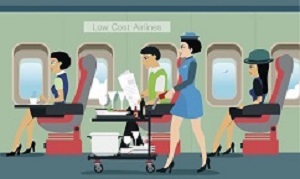 A US study of transcontinental flights found that Passengers seated within one row and within two seats laterally of a passenger with flu had an 80% or greater probability of becoming infected. Infectious crew members could infect an average of 4.6 passengers per flight.
A US study of transcontinental flights found that Passengers seated within one row and within two seats laterally of a passenger with flu had an 80% or greater probability of becoming infected. Infectious crew members could infect an average of 4.6 passengers per flight.
Researchers studied 10 transcontinental flights and meticulously tracked passenger movements to estimate the likelihood of common respiratory infections like severe acute respiratory syndrome (SARS) and influenza, which are spread by tiny droplets in the air and on surfaces. "Passengers seated within one row and within two seats laterally of the infected passenger had an 80 percent or greater probability of becoming infected," said the study. "For all other passengers, the probability of infection was less than three percent."
Researchers also warned that infectious crew members could infect an average of 4.6 passengers per flight. "Thus, it is imperative that flight attendants not fly when they are ill," said the study led by researchers at Emory University and the Georgia Institute of Technology.
The report says the good news is that public health guidelines typically go even further, urging those seated within two rows of an infected passenger to undergo surveillance for certain contagious diseases. "The authors' model argues that it requires you to be closer than previously reported – within one row and two seats of an infected passenger – as opposed to two rows regarding greatest risk of becoming ill on an airplane," said Lenox Hill Hospital emergency physician Robert Glatter, who was not involved in the study.
"But the risk was significantly less if you were seated beyond two rows of an infected person who was coughing or sneezing. This runs counter to traditional thinking that if a person coughs or sneezes anywhere in the cabin, they will infect the entire plane." The study, which was conducted during flu season, reported only one person actively coughing, "which is often not the experience of the flying public," Glatter added.
Swabs for respiratory viruses on tray tables and seat-belts also showed no trace of viruses, suggesting that most illness is spread by sneezing and coughing, not droplets that fall on surfaces or the ground. "Meticulous attention to hand washing, or using hand sanitiser remain important ways to reduce your risk of becoming ill during air travel," said Glatter.
Traveling while contagious is "an important public health concern" given that three billion passengers per year travel by air, said the study. The report says in 2014, a woman who was infected with Ebola flew from Cleveland to Dallas the night before she was hospitalised. Her trip raised alarm about the prospect of a public health emergency, but luckily, no one was infected.
According to Michael Grosso, chair of paediatrics at Northwell Health's Huntington Hospital in Huntington, New York, the study helps clarify what has long been rumoured. "I think everyone knows that travellers often experience the onset of a cold within a couple of days after flying and they naturally connect the two," he said. "The bad news is that travel websites have no option which says, 'click here to find a seat at least three away from an influenza sufferer.'"
Abstract
With over 3 billion airline passengers annually, the inflight transmission of infectious diseases is an important global health concern. Over a dozen cases of inflight transmission of serious infections have been documented, and air travel can serve as a conduit for the rapid spread of newly emerging infections and pandemics. Despite sensational media stories and anecdotes, the risks of transmission of respiratory viruses in an airplane cabin are unknown. Movements of passengers and crew may facilitate disease transmission. On 10 transcontinental US flights, we chronicled behaviors and movements of individuals in the economy cabin on single-aisle aircraft. We simulated transmission during flight based on these data. Our results indicate there is low probability of direct transmission to passengers not seated in close proximity to an infectious passenger. This data-driven, dynamic network transmission model of droplet-mediated respiratory disease is unique. To measure the true pathogen burden, our team collected 229 environmental samples during the flights. Although eight flights were during Influenza season, all qPCR assays for 18 common respiratory viruses were negative.
Authors
Vicki Stover Hertzberg, Howard Weiss, Lisa Elon, Wenpei Si, Sharon L Norris and The FlyHealthy Research Team
[link url="https://www.dailymaverick.co.za/article/2018-03-19-sick-air-travelers-mostly-likely-to-infect-next-row-study?utm_medium=email&utm_campaign=First%20Thing%2020%20March%202018%20WBC%2058&utm_content=First%20Thing%2020%20March%202018%20WBC%2058+CID_9850b0d67f89a18de0bbeed2201b99a1&utm_source=TouchBasePro&utm_term=Sickness%20in%20the%20air%20loves%20thy%20neighbour#.WrHjnkxuJYc"]Daily Maverick report[/link]
[link url="http://www.pnas.org/content/early/2018/03/13/1711611115"]PNAS abstract[/link]
